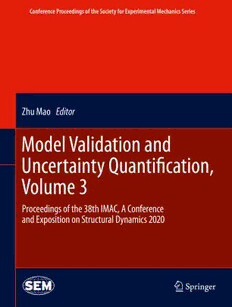Table Of ContentConference Proceedings of the Society for Experimental Mechanics Series
Zhu Mao Editor
Model Validation and
Uncertainty Quantification,
Volume 3
Proceedings of the 38th IMAC, A Conference
and Exposition on Structural Dynamics 2020
Conference Proceedings of the Society for Experimental Mechanics
Series
SeriesEditor
KristinB.Zimmerman,Ph.D.
SocietyforExperimentalMechanics,Inc.,
Bethel,CT,USA
TheConferenceProceedingsoftheSocietyforExperimentalMechanicsSeriespresentsearlyfindingsandcasestudiesfrom
a wide range of fundamental and applied work across the broad range of fields that comprise Experimental Mechanics.
SeriesvolumesfollowtheprincipletracksorfocustopicsfeaturedineachoftheSociety’stwoannualconferences:IMAC,
AConferenceandExpositiononStructuralDynamics,andtheSociety’sAnnualConference&Expositionandwilladdress
criticalareasofinteresttoresearchersanddesignengineersworkinginallareasofStructuralDynamics,SolidMechanics
andMaterialsResearch
Moreinformationaboutthisseriesathttp://www.springer.com/series/8922
Zhu Mao
Editor
Model Validation and Uncertainty
Quantification, Volume 3
Proceedings of the 38th IMAC, A Conference and Exposition
on Structural Dynamics 2020
Editor
ZhuMao
Department,DandeneauHall211
UnivofMassachusetts,MechanicalEngg
Lowell,MA,USA
ISSN2191-5644 ISSN2191-5652 (electronic)
ConferenceProceedingsoftheSocietyforExperimentalMechanicsSeries
ISBN978-3-030-48778-2 ISBN978-3-030-47638-0 (eBook)
https://doi.org/10.1007/978-3-030-47638-0
©TheSocietyforExperimentalMechanics,Inc.2020
Thisworkissubjecttocopyright.AllrightsarereservedbythePublisher,whetherthewholeorpartofthematerialisconcerned,specificallytherights
oftranslation,reprinting,reuseofillustrations,recitation,broadcasting,reproductiononmicrofilmsorinanyotherphysicalway,andtransmissionor
informationstorageandretrieval,electronicadaptation,computersoftware,orbysimilarordissimilarmethodologynowknownorhereafterdeveloped.
Theuseofgeneraldescriptivenames,registerednames,trademarks,servicemarks,etc.inthispublicationdoesnotimply,evenintheabsenceofaspecific
statement,thatsuchnamesareexemptfromtherelevantprotectivelawsandregulationsandthereforefreeforgeneraluse.
Thepublisher,theauthors,andtheeditorsaresafetoassumethattheadviceandinformationinthisbookarebelievedtobetrueandaccurateatthedate
ofpublication.Neitherthepublishernortheauthorsortheeditorsgiveawarranty,expressedorimplied,withrespecttothematerialcontainedhereinor
foranyerrorsoromissionsthatmayhavebeenmade.Thepublisherremainsneutralwithregardtojurisdictionalclaimsinpublishedmapsandinstitutional
affiliations.
ThisSpringerimprintispublishedbytheregisteredcompanySpringerNatureSwitzerlandAG
Theregisteredcompanyaddressis:Gewerbestrasse11,6330Cham,Switzerland
Preface
Model Validation and Uncertainty Quantification represents one of eight volumes of technical papers presented at
the 38th IMAC, A Conference and Exposition on Structural Dynamics, organized by the Society for Experimental
Mechanics, and held in Houston, Texas, February 10–13, 2020. The full proceedings also include volumes on Nonlinear
Structures and Systems; Dynamics of Civil Structures; Dynamic Substructures; Special Topics in Structural Dynamics &
Experimental Techniques; Rotating Machinery, Optical Methods & Scanning LDV Methods; Sensors and Instrumentation,
Aircraft/Aerospace,EnergyHarvesting&DynamicEnvironmentsTesting;andTopicsinModalAnalysis&Testing.
Eachcollectionpresentsearlyfindingsfromexperimentalandcomputationalinvestigationsonanimportantareawithin
StructuralDynamics.ModelValidationandUncertaintyQuantification(MVUQ)isoneoftheseareas.
Modelingandsimulationareroutinelyimplementedtopredictthebehaviorofcomplexdynamicalsystems.Thesetools
powerfully unite theoretical foundations, numerical models, and experimental data which include associated uncertainties
anderrors.ThefieldofMVUQresearchentailsthedevelopmentofmethodsandmetricstotestmodelpredictionaccuracy
and robustness while considering all relevant sources of uncertainties and errors through systematic comparisons against
experimentalobservations.
Theorganizerswouldliketothanktheauthors,presenters,sessionorganizers,andsessionchairsfortheirparticipationin
thistrack.
Lowell,MA,USA ZhuMao
v
Contents
1 VariationalCoupledLoadsAnalysisUsingtheHybridParametricVariationMethod ......................... 1
DanielC.Kammer,PaulBlelloch,andJoelSills
2 BayesianUncertaintyQuantificationintheDevelopmentofaNewVibrationAbsorberTechnology......... 19
NicolasBrötzandPeterF.Pelz
3 ComparisonofComplexityMeasuresforStructuralHealthMonitoring ........................................ 27
HannahDonajkowski,SalmaLeyasi,GregoryMellos,ChuckR.Farrar,AlexScheinker,Jin-SongPei,
andNicholasA.J.Lieven
4 SelectionofanAdequateModelofaPiezo-ElasticSupportforStructuralControlinaBeamTruss
Structure.................................................................................................................. 41
JonathanLenz,MaximilianSchäffner,RolandPlatz,andTobiasMelz
5 ImpactLoadIdentificationfortheDROPBEARSetupUsingaFiniteInputCovariance(FIC)
Estimator................................................................................................................. 51
PeterLander,YangWang,andJacobDodson
6 Real-TimeDigitalTwinUpdatingStrategyBasedonStructuralHealthMonitoringSystems ................. 55
Yi-ChenZhu,DavidWagg,ElizabethCross,andRobertBarthorpe
7 OntheFusionofTestandAnalysis.................................................................................... 65
IbrahimA.Sever
8 DesignofanActuationControllerforPhysicalSubstructuresinStochasticReal-TimeHybrid
Simulations............................................................................................................... 69
NikolaosTsokanasandB.Stojadinovic
9 Output-OnlyNonlinearFiniteElementModelUpdatingUsingAutoregressiveProcess........................ 83
JuanCastiglione,RodrigoAstroza,SaeedEftekharAzam,andDanielLinzell
10 AxleBoxAccelerometerSignalIdentificationandModelling...................................................... 87
CyprienA.Hoelzl,LuisDavidAvendanoValencia,VasilisK.Dertimanis,EleniN.Chatzi,
andMarcelZurkirchen
11 Kalman-BasedVirtualSensingforImprovementofServiceResponseReplication
inEnvironmentalTests.................................................................................................. 93
SilviaVettori,EmilioDiLorenzo,RobertaCumbo,UmbertoMusella,TommasoTamarozzi,BartPeeters,
andEleniChatzi
12 VirtualSensingofWheelPositioninGround-SteeringSystemsforAircraftUsingDigitalTwins............. 107
MattiaDalBorgo,StephenJ.Elliott,MaryamGhandchiTehrani,andIanM.Stothers
13 AssessingModelFormUncertaintyinFractureModelsUsingDigitalImageCorrelation ..................... 119
RobinCallens,MatthiasFaes,andDavidMoens
vii
viii Contents
14 IdentificationofLackofKnowledgeUsingAnalyticalRedundancyAppliedtoStructural
DynamicSystems........................................................................................................ 131
JakobHartig,FlorianHoppe,DanielMartin,GeorgStaudter,TugrulÖztürk,ReinerAnderl,PeterGroche,
PeterF.Pelz,andMatthiasWeigold
15 AStructuralFatigueMonitoringConceptforWindTurbinesbyMeansofDigitalTwins ..................... 139
JánosZierath,Sven-ErikRosenow,JohannesLuthe,AndreasSchulze,ChristianeSaalbach,ManuelaSander,
andChristophWoernle
16 DamageIdentificationofStructuresThroughMachineLearningTechniqueswithUpdatedFinite
ElementModelsandExperimentalValidations...................................................................... 143
PanagiotisSeventekidis,DimitriosGiagopoulos,AlexandrosArailopoulos,andOlgaMarkogiannaki
17 ModalAnalysesandMeta-ModelsforFatigueAssessmentofAutomotiveSteelWheels........................ 155
S.Venturini,E.Bonisoli,C.Rosso,D.Rovarino,andM.Velardocchia
18 TowardstheDevelopmentofaDigitalTwinforStructuralDynamicsApplications............................. 165
PaulGardner,MattiaDalBorgo,ValentinaRuffini,YichenZhu,andAidanHughes
19 AnImprovedOptimalSensorPlacementStrategyforKalman-BasedMultiple-InputEstimation............ 181
LorenzoMazzanti,RobertaCumbo,WimDesmet,FrankNaets,andTommasoTamarozzi
20 Towards Population-Based Structural Health Monitoring, Part IV: Heterogeneous Populations,
TransferandMapping.................................................................................................. 187
PaulGardner,LawerenceA.Bull,JulianGosliga,NikolaosDervilis,andKeithWorden
21 FeasibilityStudyofUsingLow-CostMeasurementDevicesforSystemIdentificationUsingBayesian
Approaches............................................................................................................... 201
AlejandroDuarteandAlbertR.Ortiz
22 KernelisedBayesianTransferLearningforPopulation-BasedStructuralHealthMonitoring................. 209
PaulGardner,LawrenceA.Bull,NikolaosDervilis,andKeithWorden
23 PredictingSystemResponseatUnmeasuredLocationsUsingaLaboratoryPre-Test .......................... 217
RandyMayes,LukeAnkers,andPhilDaborn
24 RobustEstimationofTruncation-InducedNumericalUncertainty ............................................... 223
FrançoisHemez
25 FatigueCrackGrowthDiagnosisandPrognosisforDamage-AdaptiveOperationofMechanical
Systems ................................................................................................................... 233
PranavM.Karve,YulinGuo,BerkcanKapusuzoglu,SankaranMahadevan,andMulugetaA.Haile
26 AnEvolutionaryApproachtoLearningNeuralNetworksforStructuralHealthMonitoring ................. 237
TharukaDevendra,NikolaosDervilis,KeithWorden,GeorgeTsialiamanis,ElizabethJ.Cross,
andTimothyJ.Rogers
27 BayesianSolutionstoState-SpaceStructuralIdentification........................................................ 247
TimothyJ.Rogers,KeithWorden,andElizabethJ.Cross
28 AnalyzingPropagationofModelFormUncertaintyforDifferentSuspensionStrutModels................... 255
RobertFeldmann,MaximilianSchäffner,ChristopherM.Gehb,RolandPlatz,andTobiasMelz
29 Determining Interdependencies and Causation of Vibration in Aero Engines Using Multiscale
Cross-CorrelationAnalysis............................................................................................. 265
ManuKrishnan,IbrahimA.Sever,andPabloA.Tarazaga
30 DynamicDataDrivenModelingofAeroEngineResponse......................................................... 273
ManuKrishnan,SerkanGugercin,IbrahimSever,andPabloTarazaga
31 NonlinearModelUpdatingUsingRecursiveandBatchBayesianMethods ...................................... 279
MingmingSong,RodrigoAstroza,HamedEbrahimian,BabakMoaveni,andCostasPapadimitriou
Contents ix
32 TowardsPopulation-BasedStructuralHealthMonitoring,PartI:HomogeneousPopulationsandForms... 287
LawerenceA.Bull,PaulA.Gardner,JulianGosliga,NikolaosDervilis,EvangelosPapatheou,
AndrewE.Maguire,CarlesCampos,TimothyJ.Rogers,ElizabethJ.Cross,andKeithWorden
33 ADetailedAssessmentofModelFormUncertaintyinaLoad-CarryingTrussStructure...................... 303
RobertFeldmann,ChristopherM.Gehb,MaximilianSchäffner,AlexanderMatei,JonathanLenz,
SebastianKersting,andMoritzWeber
34 RecursiveNonlinearIdentificationofaNegativeStiffnessDeviceforSeismicProtectionofStructures
withGeometricandMaterialNonlinearities......................................................................... 315
KalilErazoandSatishNagarajaiah
35 AdequateMathematicalBeam-ColumnModelforActiveBucklingControlinaTetrahedronTruss
Structure.................................................................................................................. 323
MaximilianSchaeffner,RolandPlatz,andTobiasMelz
36 SiteCharacterizationThroughHierarchicalBayesianModelUpdatingUsingDispersionandH/VData.... 333
MehdiM.Akhlaghi,MingmingSong,MarshallPontrelli,BabakMoaveni,andLaurieG.Baise
37 BAYESIAN Inference Based Parameter Calibration of a Mechanical Load-Bearing Structure’s
MathematicalModel .................................................................................................... 337
ChristopherM.Gehb,RolandPlatzandTobiasMelz
38 Uncertainty Propagation in a Hybrid Data-Driven and Physics-Based Submodeling Method for
RefinedResponseEstimation .......................................................................................... 349
BhavanaValetiandShamimN.Pakzad
39 AdaptiveProcessandMeasurementNoiseIdentificationforRecursiveBayesianEstimation.................. 361
KonstantinosE.Tatsis,VasilisK.Dertimanis,andEleniN.Chatzi
40 EffectiveLearningofPost-SeismicBuildingDamagewithSparseObservations ................................ 365
MohamadrezaSheibaniandGeOu
41 EfficientBayesianInferenceofMiterGatesUsingHigh-FidelityModels......................................... 375
ManuelA.Vega,MukeshK.Ramancha,JoelP.Conte,andMichaelD.Todd
42 Two-StageHierarchicalBayesianFrameworkforFiniteElementModelUpdating............................. 383
XinyuJia,OmidSedehi,CostasPapadimitriou,LambrosKatafygiotis,andBabakMoaveni
43 BayesianNonlinearFiniteElementModelUpdatingofaFull-ScaleBridge-ColumnUsingSequential
MonteCarlo.............................................................................................................. 389
MukeshK.Ramancha,RodrigoAstroza,JoelP.Conte,JoseI.Restrepo,andMichaelD.Todd
44 OptimalInputLocationsforStiffnessParameterIdentification................................................... 399
DebasishJana,DhirajGhosh,SuparnoMukhopadhyay,andSamitRay-Chaudhuri
45 Modal Identification and Damage Detection of Railway Bridges Using Time-Varying Modes
IdentifiedfromTrainInducedVibrations ............................................................................ 405
AshishPal,AsthaGaur,andSuparnoMukhopadhyay
46 Test-AnalysisModalCorrelationofRocketEngineStructuresinLiquidHydrogen–PhaseII................ 413
AndrewM.BrownandJenniferL.DeLessio
47 AnOutput-OnlyBayesianIdentificationApproachforNonlinearStructuralandMechanicalSystems...... 431
SatishNagarajaiahandKalilErazo
Chapter 1
Variational Coupled Loads Analysis Using the Hybrid
Parametric Variation Method
DanielC.Kammer,PaulBlelloch,andJoelSills
Abstract Time-domain coupled loads analysis (CLA) is used to determine the response of a launch vehicle and payload
systemtotransientforces,suchasliftoff,engineignitionsandshutdowns,jettisonevents,andatmosphericflightloads,such
as buffet. CLA, using Hurty/Craig-Bampton (HCB) component models, is the accepted method for the establishment of
design-level loads for launch systems. However, uncertainty in the component models flows into uncertainty in predicted
system results. Uncertainty in the structural responses during launch is a significant concern because small variations in
launchvehicleandpayloadmodeshapesandtheirinteractionscanresultinsignificantvariationsinsystemloads.Uncertainty
quantification(UQ)isusedtodeterminestatisticalboundsonpredictionaccuracybasedonmodeluncertainty.Inthispaper
uncertainty is treated at the HCB component-model level. In an effort to account for model uncertainties and statistically
bound their effect on CLA predictions, this work combines CLA with UQ in a process termed variational coupled loads
analysis(VCLA).Themodelingofuncertaintyusingaparametricapproach,inwhichinputparametersarerepresentedby
random variables, is common, but its major drawback is the resulting uncertainty is limited to the form of the nominal
model. Uncertainty in model form is one of the biggest contributors to uncertainty in complex built-up structures. Model-
formuncertaintycanberepresentedusinganonparametricapproachbasedonrandommatrixtheory(RMT).Inthiswork,
UQ is performed using the hybrid parametric variation (HPV) method, which combines parametric with nonparametric
uncertainty at the HCB component model level. The HPV method requires the selection of dispersion values for the HCB
fixed-interface(FI)eigenvalues,andtheHCBmassandstiffnessmatrices.Thedispersionsarebaseduponcomponenttest-
analysis modal correlation results. During VCLA, random component models are assembled into an ensemble of random
systemsusingaMonteCarlo(MC)approach.CLAisappliedtoeachoftheensemblememberstoproduceanensembleof
system-levelresponsesforstatisticalanalysis.Theproposedmethodologyisdemonstratedthroughitsapplicationtoabuffet
loadsanalysisofNASA’sSpaceLaunchSystem(SLS)duringthetransonicregime50safterliftoff.Corestage(CS)section
shearsandmomentsarerecovered,andstatisticsarecomputed.
Keywords Uncertaintyquantification · Hurty/Craig-Bampton · Randommatrix · Modelform · Coupledloadsanalysis
Acronyms
CLA coupledloadsanalysis
CS corestage
DCGM diagonalcross-generalizedmassmetric
DOF degreesoffreedom
FEM finiteelementmodel
FI fixed-interface
HCB Hurty/Craig-Bampton
HPV hybridparametricvariation
D.C.Kammer((cid:2))·P.Blelloch
ATAEngineering,Inc.,SanDiego,CA,USA
e-mail:[email protected];[email protected]
J.Sills
NASAJohnsonSpaceCenter,Houston,TX,USA
e-mail:[email protected]
©TheSocietyforExperimentalMechanics,Inc.2020 1
Z.Mao(ed.),ModelValidationandUncertaintyQuantification,Volume3,ConferenceProceedingsoftheSocietyforExperimental
MechanicsSeries,https://doi.org/10.1007/978-3-030-47638-0_1

